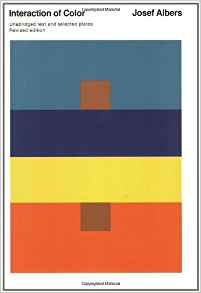It was time to paint the walls of my husband’s office. And knowing that the color I had hand-adjusted for our other rooms was a winner, and that we still had a good amount left in the 5 gal. container, we set out to use it. Whew, it did not work in there! He has one window in that small room, and the lighting is completely different. My wonderful color looked dark and morose in a different placement. So, back to Lowes we went. Color is a fickle thing. It is entirely dependent on context.
 The mid 20th century Bauhaus instructor Joseph Albers was a master at helping his art students understand this. Using color chips and simple exercises, like “make five colors into six”, they learned the relativity of color. “In order to use color effectively, it is necessary to recognize that color deceives continually”, Albers said. Here is one exercise exampled. The brown squares are the same exact hue, but the reading of each is influenced by its surrounding colors. A dark context makes the center color lighter, a cool context makes the center color warmer and vice versa.
The mid 20th century Bauhaus instructor Joseph Albers was a master at helping his art students understand this. Using color chips and simple exercises, like “make five colors into six”, they learned the relativity of color. “In order to use color effectively, it is necessary to recognize that color deceives continually”, Albers said. Here is one exercise exampled. The brown squares are the same exact hue, but the reading of each is influenced by its surrounding colors. A dark context makes the center color lighter, a cool context makes the center color warmer and vice versa.
This relativity, this prone-ness to deception, is of interest in the time we’re in as a culture. Have you been in conversations with those who see things entirely differently than you do? It’s remarkable to me how a news story is interpreted so conversely by two folks with some of the same information. Context will determine whether the ‘facts’ being presented are orange or dark brown. I say, examine closely. Look at the context. Do some experimenting. Ask questions. You can stand and insist that orange is orange, but you could be easily wrong. Be sure about what is sure, and aware of what simply morphs. Be a humble sounding board, willing to test and to explore the assumptions being bantered and felt as ‘true’.
Deception is in the air. It’s good to do some work on this. Go back to the elementals. Albers’ students learned well because they were forced to wrestle with it. What is ‘color’ (changeable) and what is ‘fact’ (stable). What is surface charm and what is structure? What is emotion, and what is reliable here? What stands the tests of time, and what is a passing dew on the grass?